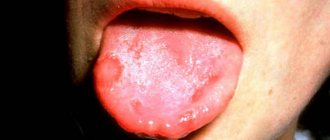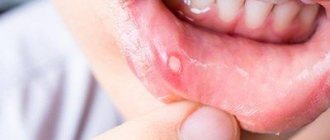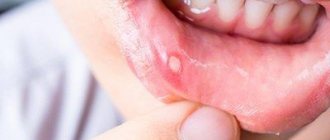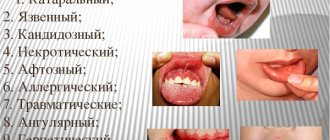| Type of stomatitis | Possible reasons | Features of the flow |
| Viral | Causative agents of herpes, measles, chickenpox, which are transmitted by airborne droplets and by contact with a carrier. | The patient's general condition is serious: the temperature rises above +380C, diarrhea, nausea and uncontrollable vomiting are possible. Bubbles filled with clear liquid appear on the mucous membrane of the mouth. Very quickly they burst, forming ulcers. But after 3-4 days they become crusty and heal on their own. The disease lasts 1-2 weeks. |
| Fungal | Candida fungus, the activity of which is provoked by decreased immunity, vitamin deficiency or hypothermia. | Fungal stomatitis most often affects children, the elderly and pregnant women. Recognizable by a white coating on the palate, tongue, and inner surface of the cheeks. Patients complain of pain while eating. |
| Aphthous (bacterial) | Decreased general and local immunity due to infection. Pathogens: staphylococci, streptococci, gonococci, mycobacteria. In women with chronic gastritis or gastric ulcer - Helicobacter pylori activity. | Aphthous stomatitis is dangerous due to its long course and high probability of relapses, which usually occur in spring and autumn. On the mucous membrane, aphthae are visible - round blisters surrounded by a scarlet border and covered with a grayish coating. They can be single or multiple, and sometimes merge into extensive lesions. |
| Catarrhal | Tartar, untreated caries, poor oral hygiene. | This is the same stomatitis of “dirty hands”. It occurs more often than other varieties, but it also occurs much more easily. You can recognize it by the pronounced soreness of the mucous membrane, its swelling and dryness. Bleeding of the cheeks, a yellowish coating on the tongue and the inner surface of the cheeks may be observed. Accompanied by an unpleasant odor from the mouth. |
| Allergic | Certain foods (often strawberries, citrus fruits), medications, oral care products, and even the materials from which crowns, veneers, fillings, and dentures are made can act as an allergen. | Allergic stomatitis is considered the most severe type of the disease. Patients complain of unbearable burning and pain even when trying to breathe air through their mouth. |
| Nicotinic | Long-term smoking | Hot smoke regularly irritates the soft and hard palates. At first, the tissues become denser, but for the patient this process is painless and therefore goes unnoticed. In the advanced stage, all soft tissues are covered with multiple ulcers. And doctors confidently call nicotine stomatitis a precancerous disease. |
Stomatitis and ulceration of the oral mucosa during pregnancy can be caused by sodium lauryl sulfate (SLS), an ingredient in most toothpastes. It is with its help that manufacturers achieve abundant foam formation. If this component is not directly indicated in the composition, you can find out about its presence by the innocuous phrase: “foaming agent obtained from coconuts.”
Do treatment methods for stomatitis depend on the timing of pregnancy?
First of all, we must keep in mind that the first, second and ninth months are the most undesirable in terms of any intervention. Therefore, it is better not to treat stomatitis during these periods. The methods depend on the form of the disease: candidal stomatitis is treated with antifungal drugs, viral - with antiviral drugs, bacterial - with antibiotics, and in the allergic form of stomatitis, contact with the allergen is excluded or antihistamines are prescribed. Whatever method is used, the dentist takes into account the patient’s condition and selects exclusively harmless means of therapy.
The dangers and consequences of stomatitis in pregnant women
Stomatitis is not a harmless disease at all! Developing against the background of reduced immunity, it further weakens the body with waste products of fungi, viruses or bacteria. And since the circulatory system of mother and fetus is still one, the danger is enormous! In the early stages, when all organs and systems are being formed, it is stomatitis that can cause a program failure, and the child will be born with a pathology.
Another danger is the transition of stomatitis to a chronic form, when the disease will subside only for a while, and after a few weeks it will reappear. Each time the course of the disease will become more and more severe: the simplest catarrhal variety will quickly turn into ulcerative stomatitis. Well, it’s not far from gangrene, which affects not only soft tissues, but also the bones of the jaw apparatus.
And even when treatment is started on time, you cannot relax! Difficulties in eating and drinking that are quite natural for stomatitis can lead to dehydration. And not only for the expectant mother herself, but also for her baby. Therefore, no matter how difficult it may be, you need to make sure that you drink at least 1.5 liters of water per day.
What should be the prevention of stomatitis during pregnancy?
The most important thing is to take good care of your oral cavity. Ask your dentist to recommend a suitable antibacterial toothpaste. Be sure to use mouthwash and dental floss. A healthy diet is also of great importance: balance your diet, do not get carried away with sweet carbohydrate foods (bacteria love them very much). Take vitamins - they will help support the body during the difficult period of bearing a baby.
Stomatitis during pregnancy: before and after photos
Experts' opinion
The effectiveness of ASEPTA rinses has been repeatedly proven by clinical studies. For example, according to A.K. Iordanishvili, Doctor of Medicine Sc., professor, North-Western State Medical University named after. I.I. Mechnikov, based on a study of 46 people suffering from gum inflammation, it was found that the use of mouth rinses “ASEPTA PARODONTAL ACTIVE” and “ASEPTA PARODONTAL FRESH” (JSC “VERTEX”, Russia) allows not only to improve oral hygiene and reduce inflammatory processes in the gums by 55.37%, but also reduce the number of relapses of localized periodontitis by 21.36%.
Sources:
- Prevention of recurrence of localized periodontitis in young A.K. YORDANISHVILI, Doctor of Medical Sciences, Professor, North-Western State Medical University named after. I.I. Mechnikov, Military Medical Academy named after. CM. Kirov, International Academy of Sciences of Ecology, Human Safety and Nature.
- Report on clinical trials to determine/confirm the preventive properties of commercially produced personal oral hygiene products: mouth rinse "ASEPTA PARODONTAL" - Solution for irrigator." Doctor of Medical Sciences Professor, Honored Doctor of the Russian Federation, Head. Department of Preventive Dentistry S.B. Ulitovsky, doctor-researcher A.A. Leontiev First St. Petersburg State Medical University named after academician I.P. Pavlova, Department of Preventive Dentistry.
- Report on determining/confirming the preventive properties of commercially produced personal oral hygiene products: Asepta toothpaste used in combination with Asepta mouthwash and Asepta gum balm Head. Department of PFS Doctor of Medical Sciences Professor S.B. Ulitovsky St. Petersburg State Medical University named after Academician I.P. Pavlova. Faculty of Dentistry. Department of Preventive Dentistry.
Preventive measures
Tips to help prevent the development of the disease:
- Thorough cleaning of not only your teeth, but also your tongue.
- Regularly replacing your old toothbrush with a new one (at least once every two to three months).
- Consume only thoroughly washed fruits and vegetables.
- The diet should be rich in minerals and vitamins.
- Avoid seeds and nuts, which carry huge amounts of bacteria.
- Try to drink only warm water at room temperature.
HRAS classification:
| CAUSES | A COMMENT | ||
| causes: | Clinically, several forms of HRAS are distinguished: | a comment: | 1) fibrinous form: the size of aphthae is 2-3 mm, heal in 6-8 days 2) small canker sores (Mikulich’s aphthae): the size of aphthae is up to 1 cm, heal in 10-14 days 3) large Setton’s aphthae: the size of aphthae is from 1 to 3 cm, heal for a very long time, up to several months, leaving scars 4) herpetiform type: the smallest aphthae that merge |
| causes: | HRAS as a symptom of the disease: | a comment: | 1) Behcet's disease 2) Reiter's disease |
| causes: | According to severity, HRAS is divided into: | a comment: | 1) mild form: 1-2 aphthae, once every 2 years 2) moderate form: 3-6 aphthae, relapse 2 times a year 3) severe form: more than 6 aphthae, relapse several times a year |
Acute gastritis
In case of acute gastritis, you should consult a doctor.
This form consists of inflammatory processes that involve the upper parts of the mucosa or penetrate into its deeper layers.
The main difference between the acute form is the high rate of development of pathology. Maximum – several days, more often – several hours.
In this case, unpleasant signs suddenly appear, the provocateur is alcohol intake, consumption of foods, medications that irritate the mucous membrane, and being in a nervous environment.
With acute gastritis, all the usual signs of this disease are observed, to which flatulence may be added. Appetite may disappear completely. If there is pain or other unpleasant sensations in the upper abdomen, you cannot ignore them.
An examination is required that will help to identify the pathology in time and correct the condition. Most often, discomfort in this area is caused by gastritis. The depth of damage in acute gastritis and the intensity of inflammation are the main indicators on which the classification of acute gastritis is based.
- Catarrhal. In this form, the inflammation is superficial and is therefore considered mild. To normalize the condition in this form, special medications cannot be taken. The pathology develops quickly, but also quickly passes without much intervention. It is difficult to confuse this form with other diseases, because the symptoms are clearly expressed. All dyspeptic symptoms are present, including diarrhea. The condition is aggravated by general malaise, lethargy, fever, and heart rhythm disturbances.
- Erosive. This form is distinguished by the characteristics of mucosal damage. Small ulcers appear on it - erosion. Such ulcers cause serious consequences. In addition to discomfort in the abdominal area, severe pain occurs, and bleeding inside the stomach may develop.
- Hemorrhagic. This form is accompanied by inflammatory processes and deep erosive lesions of the mucous membrane, which lead to bleeding. Since quite a lot of blood is released, the stool becomes black. This is what is considered the defining feature in diagnosing this form.
- Phlegmonous. With this type of gastritis, the inflammation is purulent in nature, resulting in destruction of the gastric wall. Fortunately, this form is rare. But this does not mean that you do not need to be vigilant. Indeed, with the phlegmonous form, death is common. This form can be recognized at an early stage by the usual signs of gastritis, accompanied by an increase in temperature.
How to get rid of heartburn during pregnancy, watch the video:
Symptoms
Painful wounds, erosions and ulcers form on the inner surface of the cheeks and lips, on the gums and palate. Visually, they appear as small white spots with a red border ranging in size from 1 to 10 mm. During eating or hygiene procedures, they may bleed and hurt. The disease may be accompanied by increased salivation, bad breath, loss of taste, swelling and pigmentation of the tongue, and high fever.
Stomatitis on the inside of the lip
Causes of the disease
Gastritis is an inflammatory disease of the gastric mucosa.
Gastritis manifests itself in inflammatory processes that affect the gastric mucosa. This lesion leads to disruptions in the functioning of the organ.
It is believed that most pregnant women experience gastritis if this disease has already visited them before. This rule applies to 75% of girls.
The bacterium Helicobacter pylori that enters the digestive tract is another factor that provokes gastritis.
Usually it ends up in the stomach long before the first signs of the disease appear. Having become infected even before pregnancy, women do not even suspect it, because the symptoms may not be felt for a long time.
An exacerbation begins at the moment when it is provoked by other factors. These include changes in hormonal levels, under the influence of which signs of the disease appear.
Since significant changes occur in the human body during pregnancy, all of them can also become stimulants of gastritis. This includes iron deficiency anemia, disruption of the endocrine system, and infection. There are other reasons for the development of this disease:
- non-compliance with the rules of a balanced diet;
- frequent inclusion in the diet of foods containing refined carbohydrates;
- eating foods containing preservatives, dyes, and harmful flavors;
- eating large amounts of food;
- bad habits;
- experiences, being in a stressful state.










